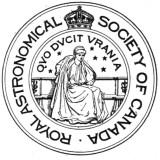Work on the Society's seal started in the 1890s but a seal was not adopted until 1905.
The Prehistory of the Society’s Seal
by R.A. Rosenfeld, RASC Archivist
Abstract
An earlier article in this series explored the iconography of the direct ancestor of the Society’s present seal introduced in 1905, and claims about its artistic parentage (Rosenfeld 2009). The saga of how the Society got its seal actually began in the closing years of the 19th century. The impassive muse who seals our fate was not the only contender a century ago, and certainly not the most novel. This episode can be read as a triumph of safe conservatism over innovation.
“Past research has identified tattoos as a way that people demonstrate their affiliation with or dedication to a group. Common uses for this type of tattooing include gang members...and modern primitives” (Bloch 2011, 64).
Symbols of institutional identity, from grants of arms, badges, and seals to logos, “graphical identities,” and “brands,” can play a significant role in shaping a successful corporate ethos, forging living members into the very body and blood of their institution. Wear the badge, aspire to the ideals, become the symbol. Seals also perform a legal function, symbolizing authentication, assent, and sanction, but their dry impress does not preclude their possessing emotional associations. The perception that no institution can be fully formed without its symbols can almost seem instinctual. C.A. Chant, the undisputed Augustus of the Society throughout the first half of the century just past, wrote in 1905 that: “For a number of Years the Society has had under consideration the selection of a design for an official seal...” (TRASC 1905, 23). The story of the process can be partly traced in our surviving records, both in manuscript (MS) and print. A few of the competing models for the Society’s seal can even be reconstructed, and they display some quite novel conceptual elements and are boldly in advance of the design that has marked us for over a century.
They also reveal something unsettling about our Victorian records, when one compares the account in the MS sources against the account in the printed sources.
| Read the rest of this article: NASA ADS | Download the entire JRASC issue: JRASC, April 2013 |
 In 1895, President Larratt W. Smith suggested that the Society, as a corporation, should have a seal to affix to its legal documents. Nothing was done for a couple of years until Dr. Edmund Meredith, another lawyer, and later Vice-President of the Society, suggested a design. Again no action was taken, perhaps because of the impending name change. The idea was not dropped completely, however, and in 1905, Dr. Chant was able to announce that a final design had been selected, and the work completed.
In 1895, President Larratt W. Smith suggested that the Society, as a corporation, should have a seal to affix to its legal documents. Nothing was done for a couple of years until Dr. Edmund Meredith, another lawyer, and later Vice-President of the Society, suggested a design. Again no action was taken, perhaps because of the impending name change. The idea was not dropped completely, however, and in 1905, Dr. Chant was able to announce that a final design had been selected, and the work completed.
The central portion of the design is the figure of Urania the muse of Astronomy. This sketch is after a sculpture by Flaxman. Above her head, on a starry background, is the motto, "Quo Ducit Urania" (i.e. where Urania leads, we follow), suggested by Professor John Fletcher, of University College. Above this again is the royal crown, and surrounding all is the name of our Society. The sketches from which the seal was cut were made by Mr. John Ellis. The Society incurred significant expenses to have the seal made: $20 in 1905 and a further $34.75 in 1906. John Ellis (1837-1923) was a lithographer of considerable skill. He was an enthusiastic amateur astronomer who hosted open-air meetings at his home on several occasions. Ellis Avenue, just west of Toronto's High Park is named for his family who originally owned 250 acres extending from the lakefront to Bloor Street.
The idea of Urania as subject for the seal seems to have been in circulation for some time. The classics were still a part of a good education, and everyone would have known who Urania was. President Paterson frequently alluded to her in his speeches and W.B. Musson in 1899 described an engraving of Urania copied from one in the Vatican, and suggested a motto "Mens Agitat Molem" (the mind is stirred by thy greatness).
A poem of four verses entitled "An Astronomer's Apostrophe to Urania" by Frederick C. Leonard was published in the Journal for October, 1923. It can be given a distinctive Canadian flavour by singing it to the tune of the haunting Huron Indian carol, "Jesus Ahatonhi." A bit of care is needed in going from lines six to seven, and the first line must be repeated at the end. Here is the first verse:
Celestial Urania,
Thy wonders we would know —
Those mysteries and marvels which
Alone inspire us so
That nightly from this Earthly sphere
We try to comprehend
Thy Universe as infinite,
And ages without end.
—Peter Broughton (from Looking Up)


